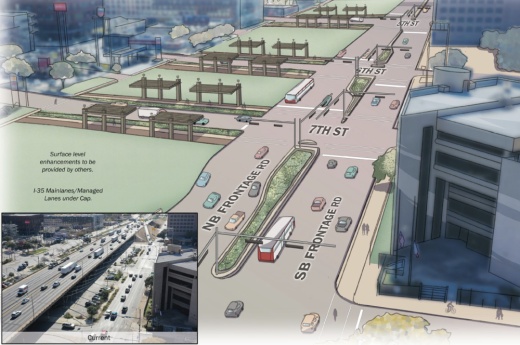The project has faced months of criticism from community members and officials over its significantly expanded footprint and number of homes and businesses that would be displaced in earlier proposals. The favored plan—known as Modified-Build Alternative 3—reduces the amount of land that would be seized.
The $4.5 billion plan would develop 42 acres of land and displace 107 homes and businesses, leading to over 600 jobs lost if the businesses do not relocate in the community study area, according to TxDOT documents.
The competing plan, Alternative 2, would displace 291 homes and businesses, amounting to 1,125 jobs lost if the businesses do not relocate in the community study area, according to TxDOT documents.
The Capital Express Central Project refers to expansion projects on I-35 from Ben White Boulevard to the south and Hwy. 290 to the north.
The project was launched in 2020 in response to safety concerns and Austin’s rising population as this segment of I-35 is the third-most congested in the state.
“The last expansion of I-35 in this area of any substance was in the mid-1970s; and as you can imagine, the population has grown since then, and will continue to grow in the future,” TxDOT Austin District Engineer Tucker Ferguson said.
The project would add two high-occupancy-vehicle lanes in each direction on the inner sections of the road. For most of the project, those two lanes would be bracketed by several main lanes—most often four—in each direction.
On the outside would be one to four frontage road lanes on each side. However, from Dean Keeton Street to 15th Street, the frontage road going in both directions would sit east of the rest of the project, then those lanes would shift to the west side of the project from 15th Street to Cesar Chavez.
The project would sink the main lanes between Airport Boulevard and Lady Bird Lake and Riverside Drive and Oltorf Street underground, remove the upper decks, and widen east-west cross-street bridges, according to the press release.
The project would allow for some sections of the sunken highway to be covered in “caps and stitches”, also known as decks and bridges, if other entities, such as The University of Texas at Austin, build and fund the work. Boulevard-style segments would run next to the decks, enhancing pedestrian and bicycle paths, according to the press release.
Decks are being evaluated between Cesar Chavez Street and Eighth Street, and UT is evaluating locations between Dean Keeton Street and MLK Jr. Boulevard on the west side of I-35. Stitches are being evaluated at the Capital Metro Red Line crossing south of Airport Boulevard, Wilshire Boulevard, 38th 1/2 Street, 32nd Street, 12th Street, 11th Street, Holly Street and Woodland Avenue, according to TxDOT documents.
Austin residents can submit public comments concerning the project to TxDOT until March 7. Community members can make comments via email, voicemail, mail or online. Comments received on time will be included in the official hearing record and reviewed and addressed by TxDOT around August, Ferguson said.
Construction will be broken into five or six separate projects with the first one, the reconstruction of the Lady Bird Lake bridge and the development of HOV lanes, slated to begin as early as mid-2024, Ferguson said.






